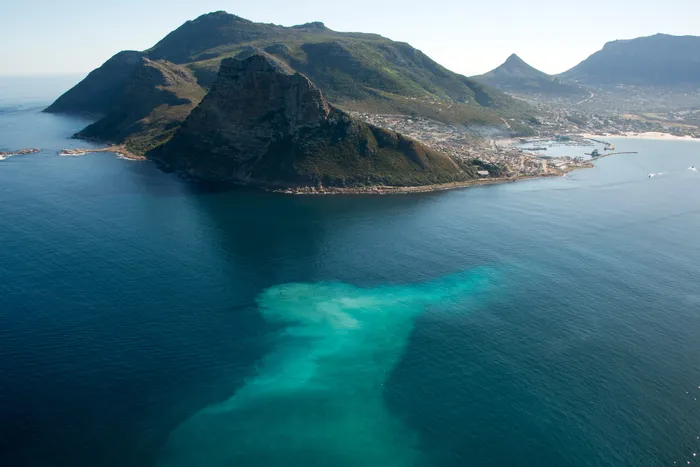Hout Bay's mussels signal a hidden marine pollution crisis

Marine conservation photographer Jean Tresfon took this picture in May 2015 of what he says is a sewage plume from the Hout Bay outfall, which can pump nearly 10 million litres of raw sewerage into the sea daily.
Image: File
A new UCT study has revealed that Hout Bay’s marine environment is seriously threatened by pharmaceutical and personal care product compounds (PPCPs) that persist and bio-accumulate in marine life, even kilometres away from pollution sources. The findings, published in Environments, raise urgent questions about sewage management, environmental monitoring and public health in one of Cape Town’s most iconic coastal areas.
Marine environment
The research team, led by UCT’s postdoctoral research fellow Dr Cecilia Ojemaye, detected a range of PPCPs in mussel tissue samples collected at significant distances from the marine outfall and the Hout Bay River mouth. These compounds, residues from common medications and personal care products, enter the marine environment through human excretion, wastewater discharge and improper disposal.
“The presence of these compounds in mussels is a red flag,” said Dr Ojemaye. “Mussels are sentinel organisms, they filter the water and accumulate pollutants, which means they are telling us a story about the health of the entire marine ecosystem.”
Sewage system
The study showed that the pollution plume from Hout Bay’s sewage discharges extends far beyond the immediate outfall area, contradicting previous assumptions that contaminants disperse quickly and harmlessly. Instantaneous modelling of bacterial indicators, such as enterococci, has been used in the past to justify the safety of marine outfalls, but researchers say this approach fails to capture the long-term build-up of persistent chemicals.
“This is not a case of ‘dilution is the solution to pollution’. These contaminants don’t just disappear, they spread settle, and accumulate in marine life, creating an extensive and ongoing impact zone,” said Ojemaye.
Hout Bay’s sewage system has long been a source of contention between residents, the municipality and environmental groups. Historical municipal decisions, including the choice of a marine outfall over land-based treatment, have been unpopular with local communities.
“The City (of Cape Town) has not provided Imizamo Yethu with adequate sanitation infrastructure for decades, leading to exceptionally high faecal content in the Disa River,” said said co-author of the study, Professor Lesley Green, a professor of earth politics and director of Environmental Humanities South at UCT.
She added that they fully support the argument by lawyers involved in a court case against eThekwini for sewage pollution to the ocean, that “while floundering and excuse-prone, [the City] is nonetheless the local executive authority”. Green further urged Cape Town to take a lead from the Minister of the Environment Affairs, who “committed the country to protect marine biodiversity when he signed the UN Oceans 2025 pledge in Paris in June this year”.
The population
The study highlighted that the marine outfall services about half of Hout Bay’s population, making it a significant source of chemical and microbial contamination. While the Hout Bay River also carries pollutants into the bay, the design and operation of the outfall itself contribute heavily to the problem.
Researchers warn that the situation poses both ecological and potential human health risks, especially if contaminated mussels and other shellfish are consumed. The bay lies within a marine protected area, making the findings particularly concerning for conservation efforts.
Health implications
Beyond environmental damage, the research points to wider public health implications, including the possible spread of antimicrobial resistance through contaminated marine environments. “We urgently need to understand whether faecal coliforms in Hout Bay are carrying antimicrobial resistance genes. If so, this could have consequences for human health that extend far beyond our coastlines,” said Ojemaye.
The study calls for a multi-pronged response, including investment in upgraded wastewater treatment, reduction of harmful chemical usage and stronger regulations on pollutant discharge. “This is especially critical in light of emerging challenges like the COVID-19 pandemic, which saw increased chemical usage, and South Africa’s ongoing energy crisis, which impacts wastewater management,” said Ojemaye.
Marine outfalls
Globally, marine outfalls are increasingly recognised as outdated and environmentally harmful. Researchers argue that replacing them with land-based treatment facilities should be a priority. Such systems can not only remove pollutants more effectively but also produce renewable energy and recover valuable resources from wastewater.
“Hout Bay’s pollution problem is not unique, but it is urgent,” said Professor Green. “This is an opportunity for innovation and collaboration. With the right technologies and political will, we can turn wastewater from a hazard into a resource.”
The research team stresses that while further studies are needed to map the pollution zone’s full extent and understand the risks of consuming contaminated seafood, immediate mitigation measures should begin without delay.
Wake-up call
Green said: “This is not just about science, it’s about protecting livelihoods, ecosystems and the health of our communities. If we wait until the damage is irreversible, it will be too late.
“The study is a wake-up call for Cape Town, urging both policymakers and the public to face an uncomfortable truth: the city’s marine environment is absorbing the cost of inadequate wastewater management. Without urgent intervention, the toxic tide will keep rising.”
Weekend Argus